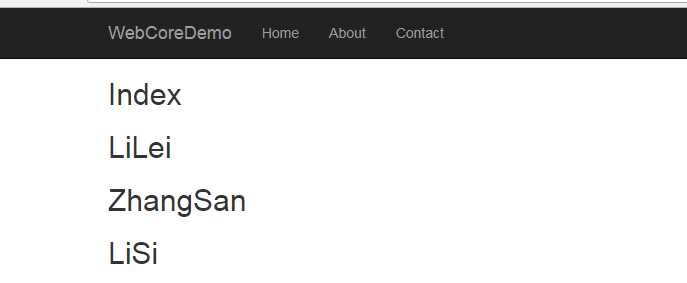本文主要是详解一下在ASP.NET Core中,自带的IOC容器相关的使用方式和注入类型的生命周期.
这里就不详细的赘述IOC是什么 以及DI是什么了.. emm..不懂的可以自行百度.
目录
ASP.NET Core中使用IOC三部曲(一.使用ASP.NET Core自带的IOC容器)
ASP.NET Core中使用IOC三部曲(二.采用Autofac来替换IOC容器,并实现属性注入)
ASP.NET Core中使用IOC三部曲(三.采用替换后的Autofac来实现AOP拦截)
今天我们主要讲讲如何使用自带IOC容器,emm..虽然自带的功能不是那么强大,但是胜在轻量级..而且..不用引用别的库..
在新的ASP.NET Core中,大量的采用了依赖注入的方式来编写代码.
比如,在我们的Startup类中的ConfigureServices里,就可以看到:
AddMvc AddDbContext 包括我们之前目录游览用到的AddDirectoryBrowser..
都是框架提供好的服务,我们直接注入就可以使用了.
1.如何注入自己的服务
下面我们就来讲讲如何注入自己的服务.
首先,我们编写我们自己的测试服务如下:
public class TestService: ITestService { public TestService() { MyProperty = Guid.NewGuid(); } public Guid MyProperty { get; set; } public List<string> GetList(string a) { return new List<string>() { "LiLei", "ZhangSan", "LiSi" }; } }
编写对应的接口代码如下:
public interface ITestService { Guid MyProperty { get; } List<string> GetList(string a); }
然后,我们要在Startup类引用 Microsoft.Extensions.DependencyInjection(ps,这命名已经很直白了..微软..扩展...依赖注入 - - ,)
修改ConfigureServices方法,如下:
public void ConfigureServices(IServiceCollection services) { services.AddMvc(); services.AddDbContext<BloggingContext>(); //这里就是注入服务 services.AddTransient<ITestService, TestService>(); services.AddDirectoryBrowser(); }
AddTransient就是注入的方法之一,泛型参数,前面一个是你服务的接口,第二个是服务的实现类..
这样,我们就完成了初步的注入操作.
那么我们如何使用我们注入的服务呢?
我们到控制器,编写代码如下:
public class DITestController : Controller { private readonly ITestService _testService; public DITestController(ITestService testService) { _testService = testService; } public IActionResult Index() { ViewBag.date = _testService.GetList(""); return View(); } }
注入的方式一般有三种,构造函数注入, 方法注入,属性注入..微软自带的这个IOC容器,默认采用了构造函数注入的方式(不支持属性注入,不过可以用第三方容器替换来实现,下篇讲)
我们编写我们的index视图如下:
@{ ViewData["Title"] = "Index"; } <h2>Index</h2> @foreach (var item in ViewBag.date) { <h2>@item</h2> }
最终效果如下:

2.注入服务的生命周期
微软给自行注入的服务,提供了3种生命周期.
Transient(瞬时的)
每次请求时都会创建的瞬时生命周期服务。这个生命周期最适合轻量级,无状态的服务。
Scoped(作用域的)
在同作用域,服务每个请求只创建一次。
Singleton(唯一的)
全局只创建一次,第一次被请求的时候被创建,然后就一直使用这一个.
如何使用这三种生命周期呢?.我们直接在注入的时候用不同的方法就行了,代码如下:
services.AddTransient<ITestService, TestService>(); services.AddScoped<ITestService2, TestService2>(); services.AddSingleton<ITestService3, TestService3>();
下面,我们就来测试一下这三种生命周期的具体生成情况
我们编写三个不同名称的接口如下:
public interface ITestService { Guid MyProperty { get; } List<string> GetList(string a); } public interface ITestService2 { Guid MyProperty { get; } List<string> GetList(); } public interface ITestService3 { Guid MyProperty { get; } List<string> GetList(); }
然后用3个类来分别实现他们.
public class TestService: ITestService { public TestService() { MyProperty = Guid.NewGuid(); } public Guid MyProperty { get; set; } public List<string> GetList(string a) { return new List<string>() { "LiLei", "ZhangSan", "LiSi" }; } } public class TestService2 : ITestService2 { public TestService2() { MyProperty = Guid.NewGuid(); } public Guid MyProperty { get; set; } public List<string> GetList() { return new List<string>() { "LiLei", "ZhangSan", "LiSi" }; } } public class TestService3 : ITestService3 { public TestService3() { MyProperty = Guid.NewGuid(); } public Guid MyProperty { get; set; } public List<string> GetList() { return new List<string>() { "LiLei", "ZhangSan", "LiSi" }; } }
每个实现类的构造函数中,我们都产生了一个新的guid,通过这个GUID,我们可以判断这个类到底重新执行过构造函数没有.
我们编写注入代码如下:
public void ConfigureServices(IServiceCollection services) { services.AddMvc(); services.AddDbContext<BloggingContext>(); services.AddTransient<ITestService, TestService>(); services.AddScoped<ITestService2, TestService2>(); services.AddSingleton<ITestService3, TestService3>(); services.AddDirectoryBrowser(); }
我们修改控制器如下:
public class DITestController : Controller { private readonly ITestService _testService; private readonly ITestService2 _testService2; private readonly ITestService3 _testService3; public DITestController(ITestService testService, ITestService2 testService2, ITestService3 testService3) { _testService = testService; _testService2 = testService2; _testService3 = testService3; } //这里采用了Action注入的方法 public IActionResult Index([FromServices]ITestService testService11, [FromServices]ITestService2 testService22) { ViewBag.date = _testService.GetList(""); ViewBag.guid = _testService.MyProperty; ViewBag.guid11 = testService11.MyProperty; ViewBag.guid2 = _testService2.MyProperty; ViewBag.guid22 = testService22.MyProperty; ViewBag.guid3 = _testService3.MyProperty; return View(); } }
这里说明一下,我们采用了Action注入的方法,新注入了一个ITestService2 ,来保证2个ITestService2 在同一个作用域.
我们编写相关的index页面,来展示这些信息如下:
@{ ViewData["Title"] = "Index"; } <h2>Index</h2> @foreach (var item in ViewBag.date) { <h2>@item</h2> } <h1>瞬时的:@ViewBag.guid</h1> <h1>瞬时的2:@ViewBag.guid11</h1> <h1>作用域的:@ViewBag.guid2</h1> <h1>作用域的2:@ViewBag.guid22</h1> <h1>全局唯一的:@ViewBag.guid3</h1>
我们运行代码,第一次访问,效果如下:

我们发现瞬时生命周期的,2次生成的GUID都不一致,说明对象不是同一个.
然而作用域生命周期的,因为在同一个作用域下,2次使用服务的GUID都是一致的,说明用的同一个对象.
我们直接刷新页面进行第二次访问.
效果如下:

瞬时的和作用域的,都继续符合我们的预期,
全局唯一生命周期的和上面第一次访问的GUID保持一致.说明2次访问,都使用的同一个对象.也符合我们的预期.
本篇到此就结束了,下篇我们讲解,如何使用第三方的Autofac来替换我们默认的IOC容器,并且使用Autofac的属性注入,来注入我们的服务. 喜欢的请点个推荐和关注,~有问题也希望各位批评指正~.
